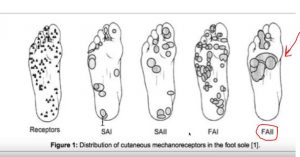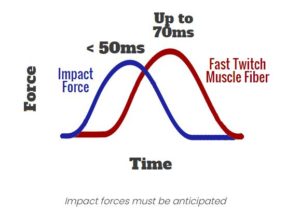restore: the legs program
impact forces: how does our body perceive and handle them?
Impact forces:
What We Learn Here WILL Enhance Our Training!
I’ve got a quick story to share with you before I get to the heart of why impact forces matter, and what we can do about them with our training.
Over the many years I’ve done gait analysis and worked with injured runners, one thing that always struck me as significant (among many things) was that almost to a person – every one of those runners had difficulty standing and balancing on a single leg. Virtually EVERY one of them. Hundreds over many years.
No doubt there could have been a few different reasons as to why this was universal for every injured runner. Suffice to say, I needed to learn more.
My curiosity eventually led me to the Evidence-Based Fitness Academy in NYC – among the leading barefoot training centers in the world, to seek certification as a Barefoot Training Specialist. What I’m sharing here in this area of the course/program, reflects some of what I’ve learned as a BTS.
Understanding Impact Forces
So HOW DOES our body handle those dreaded impact forces whenever our foot hits the ground. That’s roughly 750 to 800 times on each foot per mile, if you haven’t counted lately! 🙂
Have you ever thought about this? It’s important stuff, right?
If you consider how many runners suffer from overuse injury and also run slower due to energy leaks…then you can see how important the moment is when your foot hits the ground!
So, IF I asked you how you believe your body perceives impact forces each time you land, what would you say?
If you’re like the majority of folks I’ve asked, you’d say pressure.
And that makes sense, right? Thinking of it logically, there’s our old friend gravity pushing down on our body, increasing the pressure as we contact the ground. So that’s how we “perceive” it. Yup, makes sense.
Now going further, if you’re an educated runner (and there are plenty reading this who are educated!) who has a good understanding of running biomechanics, you might also say that our body relies on the eccentric strength of our leg muscles AND optimal joint mobility to “absorb” that impact.
I can honestly admit I’ve emphasized that over the years when speaking with runners about injury and speed. And there is some truth to it.
But it isn’t the whole truth, and it doesn’t tell the whole (or most important) story. Our collective increasing understanding of our bodies and our fascial system has helped enlighten us to what’s actually going on.
So how does our body perceive impact forces? The answer is: as vibration.
About 80% of all the small nerve proprioceptors in our foot are sensitive to vibration, making it the most important stimulus for how we perceive impact.
Now, this whole dealio could get complex really fast, and that’s not my goal.
Here’s a synopsis of what is happening:
As our foot hits the ground, the vibrations enter our muscles (assuming the skin on the bottom of our foot was able to pick up those signals quickly – remember the layers of fascia loaded with proprioceptors?).
All of the muscles in our body are surrounded by compartments, which are surrounded by, you guessed it – fascia! 🙂 As the vibrations enter the compartments, the muscles respond by contracting isometrically.
If you’re having a little trouble grasping this concept, think about a tuning fork that is vibrating. When you grab it, what happens? 🙂 It instantly stops vibrating of course!
Additionally, those isometric contractions in the leg muscles provide a splinting effect to prevent the bones from vibrating OR bending.
Now, as you can probably imagine (if I haven’t lost you yet – haha)….when I’m working with a runner who has been struggling with a stress fracture, I know instantly that their foot and leg muscles weren’t reacting and contracting fast enough to protect (and splint) the bone.
The bone ends up taking a constant beating due to excessive vibration, and the end result is often a “stress” fracture.
It’s all about the fascia!
But that’s not all. It’s our fascial system that really plays arguably the biggest role, and here’s how:
As those muscles are contracting isometrically, the fascial sheath surrounding the compartments and within and outside of the muscles, is able to slide and move with the joints, stretching and loading just like when you draw back a rubber band.
If you’ve followed along to this point, I bet you’ve already come to three really important conclusions, yes?
- If our proprioception from the ground up into our feet isn’t good, the whole shebang afterward isn’t going to work as it should. Yep, that’s true!
- If our fascial system is bound up, dried up, or lacking the optimal elasticity, we’ll move like a stiff, non-compliant dried out rubber band, instead of a like-new, super stretchy, very pliable band. That’s also true!
- More than half of your running speed comes from elastic recoil and rebound, not from muscle action! (Yes, experts have been aware of this for a long time. What we didn’t know quite as well was where that elasticity was coming from. We believed it was entirely within tendon and muscle. We now know better). 🙂
One of, if not THE primary reason why compression socks were originally created and are used is to help dampen the vibrations coming in – in effect adding to the “splinting” effect from the isometric contraction of the muscles in the leg.
Hence why they can be helpful in some instances, especially in longer runs where fatigue of the legs can be a factor.
Muscle Tuning Theory
The person who’s done the most amount of research and study on this topic is biomechanist and long time shoe researcher, Dr. Benno Nigg.
His hypothesis best expressed in his “Muscle Tuning Theory” is the deepest dive I know of on this topic.
 What does the Muscle Tuning Theory say, in a nutshell?
What does the Muscle Tuning Theory say, in a nutshell?
Our foot perceives impact forces as vibrations. These vibrations are picked up (sensory input) via mechanoreceptors (proprioceptive nerves) on the bottoms of our feet.
Interestingly, as many as 80% of the small nerve proprioceptors are sensitive to vibration.

Source: EBFA; Dr. Emily Splichal
The most important thing to remember (in addition to the importance of sensory input), is that the way our body handles these vibrations is to “dampen them” by way of isometric muscle contractions.
Now I know what you’re thinking right now. “Huh?”
Let’s back up for a moment to talk a little bit of anatomy.
In our lower limbs, our muscles are housed in four different “compartments” that are surrounded by fascial sheaths. When muscles contract isometrically, the intra- compartmental pressure of the lower leg and foot increase, which dampens the vibrations.
All muscles and soft tissue vibrate at a certain frequency. And different surfaces that we run on – dirt, grass, asphalt, or concrete – also vibrate at different frequencies.
It’s worth noting, soft tissue does not like to vibrate, so the muscles in our legs contract isometrically to stop, or dampen, the vibrations.
In order to successfully handle impact forces, your body and feet do more than simply react to those forces – they anticipate them.
How does that happen?
 Since impact forces enter the body in less than 50 milliseconds, fast-twitch muscle fibers are responsible for creating damping contractions rather than slow twitch muscle fibers. However, fast twitch fibers can sometimes take up to 70 milliseconds to meet their peak maximum contraction.
Since impact forces enter the body in less than 50 milliseconds, fast-twitch muscle fibers are responsible for creating damping contractions rather than slow twitch muscle fibers. However, fast twitch fibers can sometimes take up to 70 milliseconds to meet their peak maximum contraction.
The reaction of these muscles can’t be relied upon alone, they’re just not fast enough. Which is why our body must anticipate them…
It gets harder as we get older
As we age, we lose the crimps in the fascia, which causes a reduction in elasticity. Fascia can also start to get adhesions.
Also, as we age we lose our ability to “perceive” the ground and “react” to impact.
This lost perception reduces our ability to rapidly stiffen our leg and foot, which reduces our ability to take each foot strike and turn it into potential energy for a longer, more powerful stride.
Our ability to interact with the ground is the ‘foundation’ of efficiency AND running power. That means our ability to load and unload impact forces (which is perceiving vibration – more on this in a future post), as well as anticipate changes in topography or the surface we are running on.
When we take a closer look at the foot, what we see are thousands of small nerve mechanoreceptors that are highly senstive to specific stimuli.
“So what,” you say?
Well…we need to regularly TRAIN those small nerve mechanoreceptors on the bottoms of our feet, to be able to stiffen more quickly and effectively, and thus allow us to take longer strides naturally!
We do this through effective barefoot training. Notice I said barefoot “training,” not barefoot running.
All of the above information is WHY there’s so much emphasis placed on…
1. foot function,
2. intrinsic foot muscle strength, and
3. barefoot training
…in this program.
Without optimal small nerve proprioception and good foot and toe function, we have very little chance to be durable runners able to achieve whatever our dreams and goals may desire.
We must train our feet in a smart way!
To PRINT a PDF of all of this written information, CLICK HERE!
